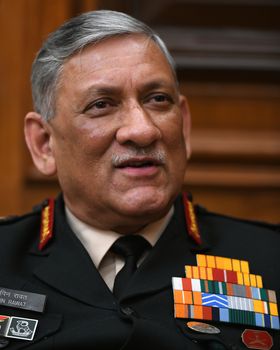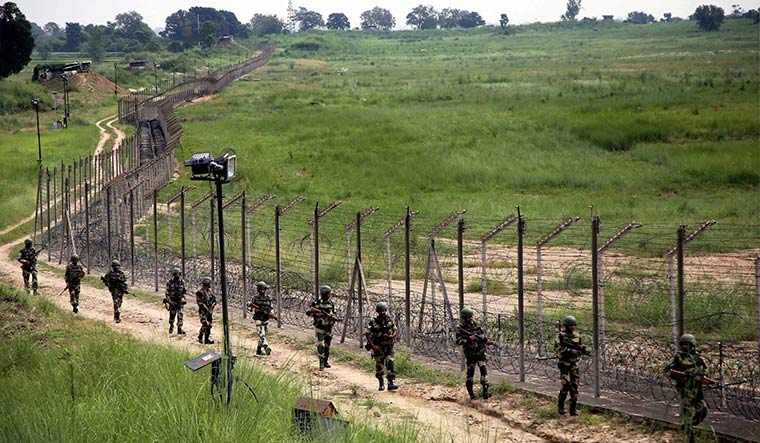GENERAL BIPIN RAWAT has had one of the toughest tenures among Army chiefs who served during peace time. He came in with the intent of modernising and ‘rightsizing’ the Army, for which he and the defence ministry got four committees of experts to study and suggest ways. Though his energies were, most of the time, taken away by the developments in Jammu and Kashmir, on the Line of Actual Control across Doklam and the northeast, he has not lost sight of his key goal, which would require political clearance for implementation.
Excerpts from an exclusive interview:
What are the challenges before the Army? How prepared are we to meet those?
The dynamics of the current security environment have multiple challenges. However, a pragmatic view is to consider low-intensity conflict as a reality [that is] likely to keep us engaged for the foreseeable future. The nature of the conventional threats is premised along disputed land borders.
Does it mean primacy for the Army?
An inherent primacy of the land forces. Terrorism forces us to commit resources, and also troops, to counter this threat. It remains our foremost challenge. Operationally, we have retained and maintained moral ascendancy on all our borders through proactive tactical operations. We have maintained the tempo of operations against terrorists through credible intelligence and ground level synergy with state police and paramilitary forces, with minimum inconvenience to local population.
And in the northeast?
Synergised intelligence-based operations have contained violence to a large extent there. This, despite the abrogation of ceasefire by NSCN(K). The security along the Indo-Myanmar border has been beefed up. While we have carried out our operations with diligence, we have also been engaging with the locals through Operation Sadbhavana and Samaritan.
You have ordered four studies on restructuring, or what is called the ‘rightsizing’ of the Army. Can you tell us more?
The committee of experts headed by Lieutenant General (retd) D.B. Shekatkar was tasked by the ministry to look into certain aspects to enhance combat capability, and also to rebalance defence expenditure. The committee’s recommendations are in various stages of implementation. In addition, we are examining avenues for rightsizing the Army. While manpower requirements along our borders and insurgency-hit areas are crucial, there is still scope for determining redundant functions at all levels, and [reducing] redundant manpower in non-core areas. Recommendations for optimisation, if found operationally viable, will be implemented. This would also lead to savings in the budget.
Are you confident of political support for such a move, which would mean fewer jobs?
Do not look at the armed forces, the Army in particular, as an agency for job creation. In the Army, you need people with fervour. There are hardships. You cannot have terms and conditions that I will go there, and I will not go there. Yet, at the same time, we are the force that provides good opportunities for employment. I am not saying that we do not provide employment. But, it should not be the only factor. Yes, we do impart skills. When they leave the Army, they leave with a lot more skills [than when they had joined].
There is a lot of talk about creating integrated battle groups (IBGs) to replace the existing divisional or corps headquarters.
The concept of IBGs entails combining selected combat and combat-support entities to create integrated all-arms groupings. The intent is to structure our organisation on how we intend to fight, primarily within existing resources, and in doing so aggregate the capabilities of different entities. This concept is in vogue in many armed forces in the world. Of course, we will need IBGs to be tailor-made to our context. There is a study going on and it is being finalised. Some aspects do require test-bedding prior to adoption. The test-bedding will be done in the coming months.
How is the Army’s position vis-a-vis China and Pakistan?
[With China] we have a very functional and effective border management system in place. While the two countries have a historical boundary dispute, very deliberate and considered procedures ensure that the sensitivities of the two sides are respected, and that they do not lead to tensions on the Line of Actual Control. These procedures are working, [as can be seen from the fact] that despite differences in perception, we have ensured peace and tranquillity.
The Chinese are building a lot of infrastructure on their side after Doklam.
We are also doing it. Today, China is developing infrastructure on its side because it has got the resources. We are also building roads. We could not do it some years ago. But now we have decided to prioritise it, so we are focusing on it. We have enhanced our military-to-military engagement with the PLA. We just had the Hand-in-Hand joint military exercise in China. Things have changed after Doklam in a positive way.
And, the situation in Jammu and Kashmir?
In J&K, on the Line of Control, there is a robust counter-infiltration deployment. Terrorists have found it difficult to infiltrate because of our dynamic response against any attempt at infiltration. They have attempted to infiltrate through other areas like the International Border sector of J&K [which is guarded by the Border Security Force]. We are taking measures along with other security forces and other agencies to deal with these.
How is the situation in the valley now?
We had a big turmoil in 2010. We witnessed stone pelting on Amarnath pilgrims in 2008-09. We adopted a very soft approach towards terrorists. We started a concept called ‘Ji Janab’. And, we started becoming very friendly with people. We allowed them to operate more freely. Then came the floods in Kashmir (September 2014). Despite being badly affected by the flood ourselves, we reached out to people as much as we could. We supported them. The time we were allowing space to the people of Kashmir, the impression we gathered was that this period was utilised [by the insurgents] to consolidate. Had that not been the case, then how was it that in 2016, when [the assassination of] Burhan Wani happened, the tide suddenly turned? And we find, people suddenly saying that there are so many terrorists in the valley, that all of them have weapons, and that they had been able to muster this stone-pelting brigade in numbers.
What does that mean?
That means there were undercurrents for recreating disturbance in the valley. That is what we are facing today. Thereafter, when the situation turned ugly, people actually started believing that now they [the insurgents] got the better of security forces. Indian security is not weak. No matter how much the adversaries try, it is not easy for them to suddenly take over Kashmir. It is more important for people to understand that they are going nowhere. They are only being used as cannon fodder.
Today, we are not doing the operations the way we used to do earlier. Cordon-and-search operations have been stopped. Operations are being done with minimum inconvenience to the people. Yet, the people are not understanding because they those who are compelling them to join terrorism. But, I will tell you one thing—the people of Kashmir are wise. They will gradually understand the game—that they are being used by vested interests.
Do you see signs of improvement?
From September onwards, the [number of] locals joining militancy has come down. Some wisdom is dawning on the people that this is not the right way. Gradually, the people will themselves realise that picking up arms is not in their best interests. It is only ruining the youth of Kashmir, ruining the development of the state. You are seeing the signs—the way the panchayat elections have taken place. Once you get governance in hand, you move forward, and development will come your way, the way you want it to be.
Has the imposition of Governor's rule helped the Army?
Yes, I would say, it has helped to an extent.
Can you tell us about your modernisation plans?
Our modernisation strategy covers the entire spectrum of conflict. It is structured along three cardinal approaches. The first is to address the conventional warfare capability. For that, we are investing in futuristic weapon systems like [improved] combat vehicles, artillery guns, air defence platforms, Army aviation and so on. Modernisation of infantry weapons is a high priority. [The emphasis is] on lethality and survivability. The second category is the support systems required to augment these platforms. Our roadmap aims at harnessing technology in electronic warfare, intelligence, surveillance and reconnaissance. The third category would be the requirements for the ongoing operations.
These plans are aligned with ‘Make in India’ initiatives. The defence ministry has further strengthened [our hands] by according enhanced financial powers to meet instant requirements.



